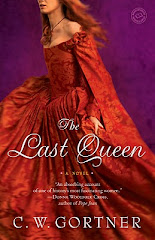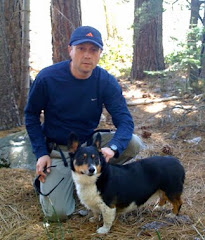 d to post this blog's second interview with a male writer of historical fiction, the incomparable John Speed. Booklist described John's first novel, THE TEMPLE DANCER, set in 17th century India, as "lavish and lush . . . Maya, a dazzling temple dancer bought by a savvy Portuguese businessman as a gift for the grand vizier of Bijapur, is transported via caravan to her new master [facing] a new danger around every bend. Chock-full of sex, suspense, and peril, this high-voltage adventure yarn will rapidly transport willing readers to a vanished time and place." His second novel -- released today! -- is TIGER CLAWS, and is the middle volume in his epic trilogy charting Mogul emperor Shah Jahan's declining years. TIGER CLAWS builds on elements John established in THE TEMPLE DANCER, but takes the plot further into the intrigues and lethal conspiracies of the royal court and struggle for the throne. It's #1 on my To-Read list.
d to post this blog's second interview with a male writer of historical fiction, the incomparable John Speed. Booklist described John's first novel, THE TEMPLE DANCER, set in 17th century India, as "lavish and lush . . . Maya, a dazzling temple dancer bought by a savvy Portuguese businessman as a gift for the grand vizier of Bijapur, is transported via caravan to her new master [facing] a new danger around every bend. Chock-full of sex, suspense, and peril, this high-voltage adventure yarn will rapidly transport willing readers to a vanished time and place." His second novel -- released today! -- is TIGER CLAWS, and is the middle volume in his epic trilogy charting Mogul emperor Shah Jahan's declining years. TIGER CLAWS builds on elements John established in THE TEMPLE DANCER, but takes the plot further into the intrigues and lethal conspiracies of the royal court and struggle for the throne. It's #1 on my To-Read list.
John is a lyrical writer who brings to life and make comprehensible to Westerners all the complex beauty and dangers of 17th century India. In an era densely populated by Anglo Saxon themes, John's novels are what I read this genre for-- full of human drama and passion, yet always true to the time. I must admit, I'd never thought much about India in the past, but after reading THE TEMPLE DANCER I was hooked! Take your elephant to the nearest bookstore and plunge into the exotic temptations of John Speed's world, and discover for yourself why he's become one of the most talented writers in the genre.

And now, without further ado, I give you Mr. John Speed:
1. What inspired you to write historical fiction? Can you tell us why you chose this particular period of time?
This period in India's history (ca. 1657) pressed all my buttons. I've been fascinated since high school by mystic Hinduism, mystic Islam (Sufism), and the classical Indian music and dance. All were flourishing mightily at this time. Add to the mix the influx of European traders and mercenaries, the ascendance of eunuchs into positions of great power, and the turbulent political situation -- well, it's just made to order. Like shooting fish in a barrel. With a setting so full of drama and emotion, virtually anyone could write a great historical novel.
2. THE TEMPLE DANCER features women protagonists in 17th century India. As a writer, how did you slip into a woman's P.O.V., particularly one of thisera? Did you find it easy or challenging?
Let me be clear: I don't "slip" into a woman's point of view. I enter it cautiously, full of trepidation, as one might explore a dark cavern. Women have always been and continue to be a mystery. In my writer's workshops, my female colleagues regularly beat me around the head and shoulders whenever one of my heroines expressed a thought. I at last found my way by describing my women characters's actions and sensations from their point of view. I expressed their thinking rarely, and then extremely cautiously. This approach has proven very successful.
3. When it comes to building a sense of time and place, how do you go about recreating the past for your reader?
Actually, I make very little effort to describe a time or place, per se. You may have heard the term Sense-memory: it's used by method actors: they try to recall the sensations surrounding a memory: the play of light beneath a half-closed shade, the noise of cicadas in the background, and rough sighs and far-off thunder, the smells of jasmine, shampoo, and new-poured asphalt, the kiss of a spring breeze on wam skin, the salt-sweet taste of a pair of sunburned lips. Once the sensations get recalled, the actor can easily remember the feelings of that moment. In the same way, I try to incorporate vivid descriptions of sensations, and hope that these will inspire the reader to imagine the time and place I hope to describe. In effect I try to put them in The Present, 350 years ago: a Present where eunuchs ride on the backs of elephants.
4. If you had to dilute the essence of your book into one sentence, what would it be?
"Gotta dance."
5. Historical fiction readers can be divided over the need for historical accuracy in a novel, versus the demands of the story. When these two issues come into conflict, how do you go about resolving them in your work?
There has never been any conflict in my mind. I recognize "history" for what it is: the current way the power-structure describes the past. I'm old enough to have seen vast quantities of "history" rewritten -- and in the case of Indian History, have seen two or three throrough re-writes. Accuracy means, in effect, flavor of the month. I ignore "history" and try to find the truth of people living their lives. Oddly, I have in recent years seen my "imagined" versions of historical incidents -- scenes that appeared to be in conflict with "accurate" history -- reflect the New Accepted versions of those incidents. History changes; humanity doesn't. The deeper I plumb human emotion, more accurate will my versions become.
6.Tell us a little about your journey to publication.
First there was My Big Book (its working title was Shivaji). I'd worked on it off and on for 20 years. I ran into a story about the bandit-king Shivaji and his wars with the Moguls in a book about my spiritual master Meher Baba. I looked up the story in the encyclopedia, and I was off. I sketched some plot notes on the spot (I had never written a word of fiction), and began to read everything I could get my hands on about the period. In the end I visited India a dozen times or so. Got a bit obsessed, actually. One day, I had a bit of windfall and took off about 18 months to write the novel. The finished MS -- all 2000++ pages -- got read by Jean Naggar, a great literary agent. She sent me a very perturbed letter in response. The book, she told me, was very good, but completly too long. Clearly if I knew how to cut it down to a reasonable size, I would have done so, so clearly I didn't know. She suggested the names of a few freelance editors who might be able to help cut the book. Eventually , Maureen Baron, the former editor of New American Library worked with me. She chopped out about half the book, making little notes like "You'll need to connect these passages", and so on. She was very skilled and very smart and I learned a ton from her edits.
I had just finished a final version of this much reduced manuscript on Sept 11. The mailman stopped to watch a few moments of the TV newscasts when he picked up the package.About 2 months later, I was visiting New Jersey, when Jean called to say that she wanted to represent me. I was on the NJ Turnpike when news came of an airplane crash in Long Island. By the time I reached the entrance to the Lincoln Tunnel, Mayor Giuliani had decided to close off access to the city. I was one car away from the toll booths and Manhattan when a convoy of National Guardsmen drove into the plaza, lifted their rifles, and turned me (and hundreds of others) away.Oddly, the ferries were still running, though all car, bus, train, and plane traffic had been closed down. Since I was only about 5 miles from Hoboken, I drove there. I got on the last ferry that was allowed to cross the river. The ferry landed at a temporary dock near the world trade center. The "pile" was still smoking.The sun shone bright, the air felt crisp. For the poor New Yorkers who had lived through 9/11, the weather seemed eerily similar to the day of that tragedy. I stood on a street corner, waving at taxis for close to 15 minutes; none would stop. Eventually a traffic cop saw my dilemma and waved down an empty cab, all but ordering the driver to take me to Jean's office on the East Side.
So I came to meet Jean Naggar, who has been a steadfast friend and ideal mentor. She was very excitied about Shivaji, and believed it could be a big hit.Six months later, Shivaji had received lots of praise from publishers, but no bids. Jean was frustrated, probably more than me. I askedd what was wrong with the book -- she wouldn't say anything. So I took a different tack: If I was going to write a different book about the period, what would you want to see?So she described a book to me: Full of young women and dangerous men, and elephants, and eunuchs, and numerous characters from Shivaji--that's what she'd want to see. And I realized that I actually had a lot of story like that in the scraps from the cut novel.So I pieced together "The Temple Dancer". Which in many ways is gentle pre-amble to the much heavier, denser work that follows. While it hasn't been a Huge Seller in the US, it blew the doors off in France, where it was Book of the Month club selection (as it was in Portugual). I started getting fan mail in French way before the US version came out, and have seen YouTube tributes to the book and fan shrines to Maya. The french version was quite beautiful, the translation was much more lyrical than my most lyrical English.
7. Tell us about your next project.
The first part of my Uber-Epic, "Tiger Claws" comes out Today, as a matter of fact (Sept 4, 2007). Same time and place as Temple Dancer, some of the same characters, but in every respect a completely distinct work. Very violent, dense, and if I may so, thrilling. No romance, per se. A huge cast, buckets of drama, and plot. I do like plot.
8. Anything else you'd like to share with our readers?
I wish to thank them. God bless book readers! And especially My book readers.
Thank you, John. You can visit him at: http://thetempledancer.com/













1 comment:
I read The Temple Dancer not too long ago, and really enjoyed it! I am looking forward to reading the next book!
Post a Comment